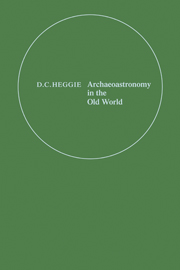Book contents
- Frontmatter
- Contents
- PREFACE
- LIST OF CONTRIBUTORS
- INVITED PAPERS
- MEGALITHIC ASTRONOMY: HIGHLIGHTS AND PROBLEMS
- ARCHAEOLOGY AND ASTRONOMY: AN ARCHAEOLOGICAL VIEW
- THE STATISTICAL APPROACH
- STATISTICAL AND PHILOSOPHICAL ARGUMENTS FOR THE ASTRONOMICAL SIGNIFICANCE OF STANDING STONES WITH A SECTION ON THE SOLAR CALENDAR
- MEGALITHIC ASTRONOMICAL SIGHTLINES: CURRENT REASSESSMENT AND FUTURE DIRECTIONS
- ASPECTS OF THE ARCHAEOASTRONOMY OF STONEHENGE
- IMPLICATIONS FOR ARCHAEOLOGY
- PI IN THE SKY
- CONTRIBUTED PAPERS
- INVITED PAPER
- INDEX
ARCHAEOLOGY AND ASTRONOMY: AN ARCHAEOLOGICAL VIEW
Published online by Cambridge University Press: 05 November 2011
- Frontmatter
- Contents
- PREFACE
- LIST OF CONTRIBUTORS
- INVITED PAPERS
- MEGALITHIC ASTRONOMY: HIGHLIGHTS AND PROBLEMS
- ARCHAEOLOGY AND ASTRONOMY: AN ARCHAEOLOGICAL VIEW
- THE STATISTICAL APPROACH
- STATISTICAL AND PHILOSOPHICAL ARGUMENTS FOR THE ASTRONOMICAL SIGNIFICANCE OF STANDING STONES WITH A SECTION ON THE SOLAR CALENDAR
- MEGALITHIC ASTRONOMICAL SIGHTLINES: CURRENT REASSESSMENT AND FUTURE DIRECTIONS
- ASPECTS OF THE ARCHAEOASTRONOMY OF STONEHENGE
- IMPLICATIONS FOR ARCHAEOLOGY
- PI IN THE SKY
- CONTRIBUTED PAPERS
- INVITED PAPER
- INDEX
Summary
Abstract. This paper examines some of the problems of the archaeological evidence from sites for which astronomical interpretations have been proposed; these include problems of interpretation caused by the use of many prehistoric sites over a long period of time, and difficulties raised by the absence of a firm chronological frame-work. The absence of detailed gazetteers for many of the types of site under discussion is also stressed. A number of excavations are used to contrast the material available to the prehistorian and to the astronomer.
Introduction
The astronomical interpretation of stone circles and standing stones has a long history; in the late seventeenth century, for example, Martin Martin, writing about the Ring of Brodgar and the Stones of Stenness in Orkney, records that ‘Several of the Inhabitants have a Tradition that the Sun was worshipped in the larger, and the Moon in the lesser Circle’ (1716, 365). In recent years a scientific basis for interpretation of the archaeological evidence in astronomical terms has been proposed by Alexander Thom (Thom, A. 1967; 1971; Thom & Thom 1978). In 1965 he began his introduction to megalithic astronomy: ‘Much has been written for and against the astronomical significance of the stone circles, stone alignments, etc., which are scattered throughout these islands and indeed much further afield. There is, however, universal agreement that the erectors, herein called for convenience Megalithic man, marked the rising and setting points of the solsticial Sun’ (Thom, A. 1965, 1).
- Type
- Chapter
- Information
- Archaeoastronomy in the Old World , pp. 25 - 44Publisher: Cambridge University PressPrint publication year: 1982



